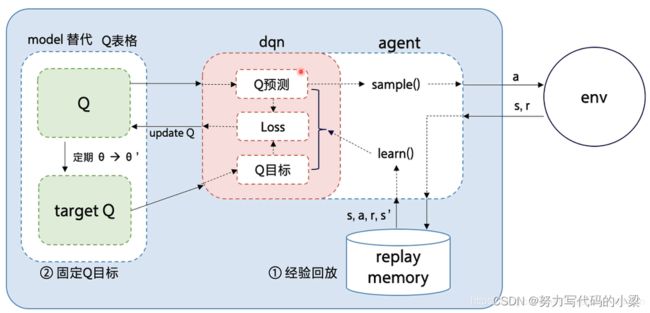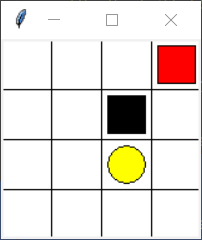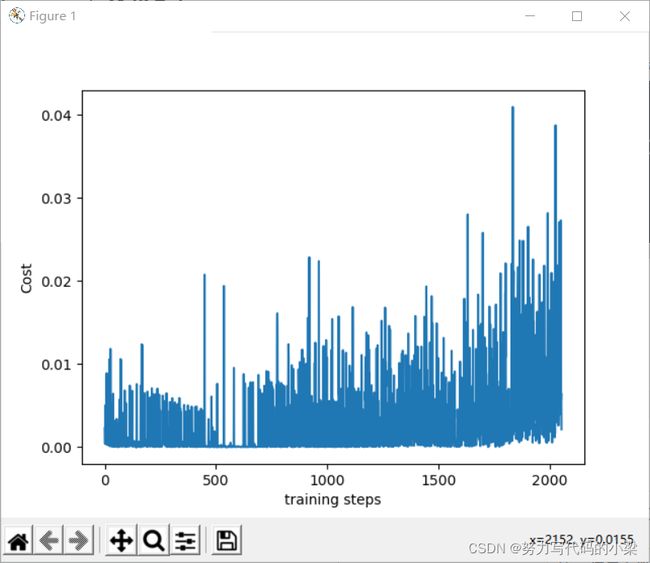【强化学习】 Nature DQN算法与莫烦代码重现(tensorflow)
DQN,(Deep Q-Learning)是将深度学习与强化学习相结合。在Q-learning中,我们是根据不断更新Q-table中的值来进行训练。但是在数据量比较大的情况下,Q-table是无法容纳所有的数据量,因此提出了DQN。DQN的核心就是把Q-table的更新转化为函数问题,通过拟合一个function来代替Q-table产生Q值。
一、DQN算法原理
强化学习算法可以分为三大类:value based,policy based和actor critic。以DQN为代表的是value based算法,这种算法只有一个值函数网络,没有policy网络。
在DQN(NIPS 2013)里面,我们使用的目标Q值的计算方式为:
这里目标Q值的计算使用到了当前要训练的Q网络参数来计算![]() ,但实际上,我们又通过yj来更新Q网络参数。两者循环依赖,迭代起来相关性太强,不利于算法的收敛。因此一个改版的DQN:Nature DQN尝试使用两个网络结构完全相同的神经网络来减少目标Q值计算和要更新Q网络参数之间的依赖关系。下面是对Nature DQN的介绍(以下Nature DQN 均称DQN)。
,但实际上,我们又通过yj来更新Q网络参数。两者循环依赖,迭代起来相关性太强,不利于算法的收敛。因此一个改版的DQN:Nature DQN尝试使用两个网络结构完全相同的神经网络来减少目标Q值计算和要更新Q网络参数之间的依赖关系。下面是对Nature DQN的介绍(以下Nature DQN 均称DQN)。
二、Nature DQN结构简介
DQN和Qlearning一样,都是采用off-policy的方式。但DQN有两个创新点,一是experience replay,即经验回放,二是Fixed Q-target。
Experience replay,经验池回放,我们将agent在每个时间步骤的经验储存在数据中,将许多回合汇聚到一个回放内存中,数据集D=e1,...,eN,其中![]() 。在算法的内部循环中,我们会把从部分数据中进行随机抽样,将抽取的样本作为神经网络的输入,从而更新神经网络的参数。使用经验回放的优势有:
。在算法的内部循环中,我们会把从部分数据中进行随机抽样,将抽取的样本作为神经网络的输入,从而更新神经网络的参数。使用经验回放的优势有:
1、经验的每个步骤都可能在许多权重更新中使用,这会提高数据的使用效率;
2、在游戏中,每个样本之间的相关性比较强,相邻样本并不满足独立的前提。机器从连续样本中学习到的东西是无效的。采用经验回放相当于给样本增添了随机性,而随机性会破坏这些相关性,因此会减少更新的方差。
Fixed Q-targets,在DQN中采用了两个结构完全相同的神经网络,分别为Q-target和Q-predict,但Q-target网络中采用的参数是旧参数,而Q-predict网络中采用的参数是新参数。Q-predict网络的参数每一次训练都会根据loss函数更新,在经过一定的训练次数以后,Q-target网络的参数会从Q-predict网络中复制。这就是Fixed Q-targets。
![]() 为什么Q-target网络参数不可以每一次训练都进行更新?因为在DQN中,两个Q网络结构是完全相同的,这样会有一个新的问题,每次更新网络参数时,因为target也会更新,这样会容易导致参数不收敛。在有监督学习中,标签label都是固定的,不会随着参数的更新而改变。我们可以把Q-target当作是一只老鼠,Q-predict就是一只猫,我们的目的是希望Q-predict越接近Q-target越好,就相当于猫捉老鼠的过程。在这个过程中,猫和老是都是一直在变化的,这样猫想捉老鼠是非常困难的。但是如果把老鼠(Q-target)固定住,只允许猫(Q-predict)动,这样猫想捉住老鼠就会变得容易很多了。
为什么Q-target网络参数不可以每一次训练都进行更新?因为在DQN中,两个Q网络结构是完全相同的,这样会有一个新的问题,每次更新网络参数时,因为target也会更新,这样会容易导致参数不收敛。在有监督学习中,标签label都是固定的,不会随着参数的更新而改变。我们可以把Q-target当作是一只老鼠,Q-predict就是一只猫,我们的目的是希望Q-predict越接近Q-target越好,就相当于猫捉老鼠的过程。在这个过程中,猫和老是都是一直在变化的,这样猫想捉老鼠是非常困难的。但是如果把老鼠(Q-target)固定住,只允许猫(Q-predict)动,这样猫想捉住老鼠就会变得容易很多了。
三、算法流程
- 首先初始化Memory D,D的容量是N
- 初始化Q网络,随机生成权重

- 初始化Q-target网络,权重

- 循环遍历episode=1,2,...,M
- 初始化状态S:
- 循环遍历step=1,2,...,T:
- 用epsilon-greedy策略生成action
 :以概率epsilon随机选择一个action,或者选择
:以概率epsilon随机选择一个action,或者选择
- 执行action
 ,接收reward
,接收reward  以及新的state S_
以及新的state S_ - 将transition样本
 存入D中
存入D中 - 从D中随机抽取一个minibatch的transitions

- 如果j+1步是terminal, 令
 ,否则,令
,否则,令
- 对
 关于θ使用梯度下降法进行更新
关于θ使用梯度下降法进行更新 - 每隔C步更新Q-target网络,令

- End For;
- End For.
四、代码复现(莫烦Python)
下面我们用一个具体的例子来演示DQN的应用,这里参考了Morvan的DQN的代码,建立了一个简易的4*4宫格的具有障碍的最短路径的游戏。该游戏非常简单,基本要求就是要控制方块在不触碰黑色方块的前提找到终点。在图中每个状态的可选择的动作最多有四个:上、下、左、右。进入黑色方块位置的奖励为-1,走到终点位置的奖励为1,其余位置的奖励均为0。
在此详细讲解代码的DQN算法核心部分,环境部分代码见:https://github.com/MorvanZhou/
class DeepQNetwork:
def __init__(
self,
n_actions,#acttion space=4
n_features,#features=state
learning_rate=0.01,
reward_decay=0.9,
e_greedy=0.9,
replace_target_iter=300,
memory_size=500,#the size of memory bank
batch_size=32,
e_greedy_increment=None,
output_graph=False,#tensorboard 输出神经网络架构
):
self.n_actions = n_actions
self.n_features = n_features
self.lr = learning_rate
self.gamma = reward_decay
self.epsilon_max = e_greedy
self.replace_target_iter = replace_target_iter
self.memory_size = memory_size
self.batch_size = batch_size
self.epsilon_increment = e_greedy_increment
self.epsilon = 0 if e_greedy_increment is not None else self.epsilon_max
# total learning step
self.learn_step_counter = 0
# initialize zero memory [s, a, r, s_]#初始化经验池
self.memory = np.zeros((self.memory_size, n_features * 2 + 2))
# consist of [target_net, evaluate_net]
self._build_net()
t_params = tf.get_collection('target_net_params')
e_params = tf.get_collection('eval_net_params')
self.replace_target_op = [tf.assign(t, e) for t, e in zip(t_params, e_params)]
self.sess = tf.Session()
if output_graph:
# $ tensorboard --logdir="logs/"
# tf.train.SummaryWriter soon be deprecated, use following
tf.summary.FileWriter("logs/", self.sess.graph)
self.sess.run(tf.global_variables_initializer())
self.cost_his = []self.replace_target_op:表示Q-target网络要从Q-predict中复制神经网络的参数。
经验池(memory bank)中存放的数据样本为:当前状态,选择的动作,奖励,下一个状态
在该游戏中,状态的描述是通过16宫格中的二维的坐标来表示的,对应代码中的features。
def _build_net(self):
# ------------------ build evaluate_net ------------------
self.s = tf.placeholder(tf.float32, [None, self.n_features], name='s') # input
self.q_target = tf.placeholder(tf.float32, [None, self.n_actions], name='Q_target') # for calculating loss
with tf.variable_scope('eval_net'):
# c_names(collections_names) are the collections to store variables
c_names, n_l1, w_initializer, b_initializer = \
['eval_net_params', tf.GraphKeys.GLOBAL_VARIABLES], 10, \
tf.random_normal_initializer(0., 0.3), tf.constant_initializer(0.1) # config of layers
#第一层网络的神经元个数为n_l1:10
# first layer. collections is used later when assign to target net
with tf.variable_scope('l1'):
w1 = tf.get_variable('w1', [self.n_features, n_l1], initializer=w_initializer, collections=c_names)
b1 = tf.get_variable('b1', [1, n_l1], initializer=b_initializer, collections=c_names)
l1 = tf.nn.relu(tf.matmul(self.s, w1) + b1)
#l1层输入经过RELU激活函数,输出为[None,n_l1]
# second layer. collections is used later when assign to target net
with tf.variable_scope('l2'):
w2 = tf.get_variable('w2', [n_l1, self.n_actions], initializer=w_initializer, collections=c_names)
b2 = tf.get_variable('b2', [1, self.n_actions], initializer=b_initializer, collections=c_names)
self.q_eval = tf.matmul(l1, w2) + b2
#l2输出层结果为:[None,self_action],输出结果为Q-predict的值
with tf.variable_scope('loss'):
self.loss = tf.reduce_mean(tf.squared_difference(self.q_target, self.q_eval))
#采用Mean Square Error计算Q-predict和Q-target之间的误差
with tf.variable_scope('train'):
self._train_op = tf.train.RMSPropOptimizer(self.lr).minimize(self.loss)
#此处梯度下降采用RMSprop进行计算
# ------------------ build target_net ------------------
self.s_ = tf.placeholder(tf.float32, [None, self.n_features], name='s_') # input
with tf.variable_scope('target_net'):
# c_names(collections_names) are the collections to store variables
c_names = ['target_net_params', tf.GraphKeys.GLOBAL_VARIABLES]
#可以看到Q-target和Q-predict的网络结构完全相同,不同在于Q-target采用的参数是比较旧的,而Q-predcit采用的参数就是每次都会随着梯度计算更新。
# first layer. collections is used later when assign to target net
with tf.variable_scope('l1'):
w1 = tf.get_variable('w1', [self.n_features, n_l1], initializer=w_initializer, collections=c_names)
b1 = tf.get_variable('b1', [1, n_l1], initializer=b_initializer, collections=c_names)
l1 = tf.nn.relu(tf.matmul(self.s_, w1) + b1)
# second layer. collections is used later when assign to target net
with tf.variable_scope('l2'):
w2 = tf.get_variable('w2', [n_l1, self.n_actions], initializer=w_initializer, collections=c_names)
b2 = tf.get_variable('b2', [1, self.n_actions], initializer=b_initializer, collections=c_names)
self.q_next = tf.matmul(l1, w2) + b2以上是DQN中重要的结构:采用了两个结构完全相同,但参数不同步更新的全连接神经网络作为Q-table的代替输出Q-target和Q-predict,两个全连接神经网络都只采用了一层的隐藏层,激活函数使用了RELU,结构非常简单。当然,这里也可以采用CNN作为神经网络的结构。
def store_transition(self, s, a, r, s_):
if not hasattr(self, 'memory_counter'):
self.memory_counter = 0
#判断self对象有name特性返回True, 否则返回False。若没有这个索引值memory_counter,则令self.memory_counter=0
transition = np.hstack((s, [a, r], s_))
# replace the old memory with new memory
index = self.memory_counter % self.memory_size
#总 memory 大小是固定的, 如果超出总大小, 取index为余数,旧 memory 就被新 memory 替换
self.memory[index, :] = transition
#堆栈原理,在经验池中的数据遵循先进先出,后进后出的原则
self.memory_counter += 1 def choose_action(self, observation):
# to have batch dimension when feed into tf placeholder
observation = observation[np.newaxis, :]
#因为observation在传入时是一维的数值
#下面采取epsilon-greedy的策略
#当随机抽取数<0.9时,执行贪婪策略;当随机抽取数>0.9,则执行随机策略
if np.random.uniform() < self.epsilon:
# forward feed the observation and get q value for every actions
actions_value = self.sess.run(self.q_eval, feed_dict={self.s: observation})
action = np.argmax(actions_value)
else:
action = np.random.randint(0, self.n_actions)
return 以上两个函数是对经验池的填充和动作的选择。接下来就是对经验池中的经验进行回放以及更新Q-target网络参数。
def learn(self):
# check to replace target parameters
if self.learn_step_counter % self.replace_target_iter == 0:
self.sess.run(self.replace_target_op)
print('\ntarget_params_replaced\n')
#判断是否对Q-target网络参数进行更新,更新后打印
# sample batch memory from all memory
if self.memory_counter > self.memory_size:
sample_index = np.random.choice(self.memory_size, size=self.batch_size)
else:
sample_index = np.random.choice(self.memory_counter, size=self.batch_size)
batch_memory = self.memory[sample_index, :]
#对经验池的一个简单判断,当counter计数大于经验池容量时,说明经验池已满,因此我们直接在经验池中取样即可。若相反,说明此时经验池还未满,我们则只能对已存储了的数据进行取样
q_next, q_eval = self.sess.run(
[self.q_next, self.q_eval],
feed_dict={
self.s_: batch_memory[:, -self.n_features:], # fixed params
self.s: batch_memory[:, :self.n_features], # newest params
})
#把取样传入神经网络中进行回放
# change q_target w.r.t q_eval's action
q_target = q_eval.copy()
batch_index = np.arange(self.batch_size, dtype=np.int32)
eval_act_index = batch_memory[:, self.n_features].astype(int)
reward = batch_memory[:, self.n_features + 1]
# 这个相当于将q_target按[batch_index, eval_act_index]索引计算出相应位置的q—_target值
q_target[batch_index, eval_act_index] = reward + self.gamma * np.max(q_next, axis=1)
#以下是莫烦本人的解释:
"""
假如在这个 batch 中, 我们有2个提取的记忆, 根据每个记忆可以生产3个 action 的值:
q_eval =
[[1, 2, 3],
[4, 5, 6]]
q_target = q_eval =
[[1, 2, 3],
[4, 5, 6]]
然后根据 memory 当中的具体 action 位置来修改 q_target 对应 action 上的值:
q_target[batch_index, eval_act_index] = reward + self.gamma * np.max(q_next, axis=1)
比如在:
记忆 0 的 q_target 计算值是 -1, 而且我用了 action 0;
记忆 1 的 q_target 计算值是 -2, 而且我用了 action 2:
q_target =
[[-1, 2, 3],
[4, 5, -2]]
所以 (q_target - q_eval) 就变成了:
[[(-1)-(1), 0, 0],
[0, 0, (-2)-(6)]]
"""在上图代码中的:change q_target w.r.t q_eval's action这一部分,实际上也是DQN网络中比较难理解的部分。在DQN中,我们拥有两个神经网络,假设我们在记忆中在Q-predict网络中选择了action1,其对应的Q值=3。根据DQN的Q值更新公式,在Q-target网络中我们是根据贪婪法则选择当前状态对应的Q值最大的action。这样就会出现一种情况,当在Q-predict中选择了action1,有可能对应的Q-target中,选择的Q值最大的action是action0。因此就出现了动作位置不对应的情况,这种情况就会出现两个选择的action,无法通过计算误差反向传播更新参数。因此这部分代码就是为了解决这种情况,无论在Q-target网络中Q值最大对应的action是什么,我们都将在Q-predict网络中选择的action对应到Q-target网络中。举个例子:
Q-predict=[0,-3,0]表示这一个记忆中选用了action1,action1的Q=-3,其他的Q均为0;
Q-target=[1,0,0]表示在这个记忆中的Q=reward+gamma*maxQ(s_)=1,但是在s_上我们选取了action0,此时两个action无法对应上,我们应该把Q-target的样本修改成:[0,1,0],和Q-predict对应起来。
_, self.cost = self.sess.run([self._train_op, self.loss],
feed_dict={self.s: batch_memory[:, :self.n_features], self.q_target: q_target})
self.cost_his.append(self.cost) # 反向训练
# increasing epsilon提高选择正确的概率,直到self.epsilon_max
self.epsilon = self.epsilon + self.epsilon_increment if self.epsilon < self.epsilon_max else self.epsilon_max
self.learn_step_counter += 1
def plot_cost(self): # 展示学习曲线
import matplotlib.pyplot as plt
plt.plot(np.arange(len(self.cost_his)), self.cost_his) # arange函数用于创建等差数组,arange返回的是一个array类型的数据
plt.ylabel('Cost')
plt.xlabel('training steps')
plt.show()以下是代码运行后的游戏过程图和学习曲线:
tensorboard输出结果:
参考资料:
https://www.cnblogs.com/pinard/p/9756075.htmlhttps://blog.csdn.net/november_chopin/article/details/107912720
https://zhuanlan.zhihu.com/p/46852675
https://icml.cc/2016/tutorials/deep_rl_tutorial.pdf
https://ojs.aaai.org/index.php/AAAI/article/view/10295
以上是本教程全部内容,有问题欢迎大家在评论区里交流!




